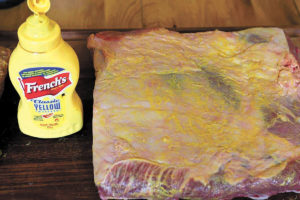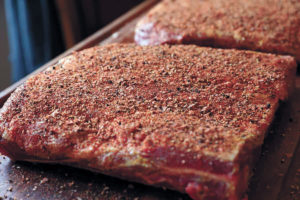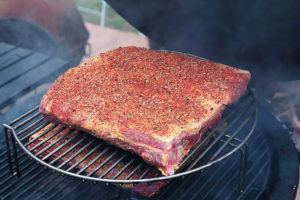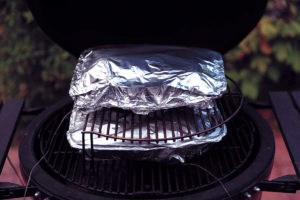
Smoked Beef Short Ribs with Mustard
Beef ribs are perfect to BBQ! Similar in taste to brisket, easier to cook and ready in half the time, while also being cheaper to buy… what’s not to like? Here’s how to turn these ‘brisket on a stick’ behemoths into a wonderful beefy treat.
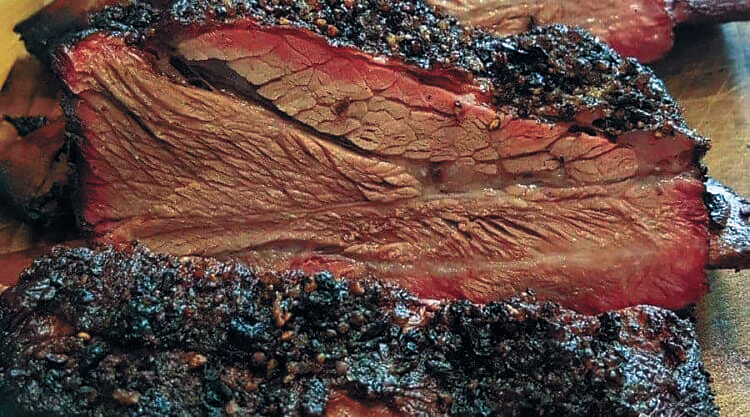
BIG, Rich, Moist and Tender Short Ribs
Beef short ribs are one of my very favorite cuts to cook on the BBQ and are every bit as good as they look! Somewhat brisket-like in taste, every bit as flavorful, moist and melt in your mouth, yet only taking 8 to 10 hours to cook instead of 16 or more for a full brisket. Smoked beef ribs (cooked correctly) are moist, tender, incredibly beefy, have an intense smoky and spicy bark with melt in your mouth meat, and they have a significant wow factor that is sure to impress your guests.
What are Beef Short Ribs?
Beef short ribs are the huge, often foot long, dinosaur-like ribs from a cow that can weigh as much as 2.5 pounds each, but 1 to 1.5 pounds each is more the norm. Pretty much always sold in joints of 3 to 4, and also known as ‘short plate ribs,’ they are the largest and meatiest of any kind of ribs. You can buy them individually, but they are better bought in plates of up to 4 ribs.
Ingredients:
- Two plates of 4x short ribs each
- 2x Tablespoons yellow mustard
- 60g Black Peppercorns
- 20g Kosher or Sea Salt
- 1 Tablespoon garlic powder
- 1 Tablespoon smoked paprika
- 1 Teaspoon cayenne pepper (optional)
Equipment:
- A smoker
- Two aluminum trays
- Aluminum foil
- Braising liquid (I use beer but beef stock also works)
What to Look For When Buying Beef Ribs
Make sure you buy short ribs, not back ribs (which have very little meat). Secondly, within the name ‘short ribs’, there are two sub-types: Plate short ribs, and chuck short ribs. Either of these are what we want. The chuck short ribs come from closer to the shoulder, tend to be slightly smaller and have more connective tissue. The plate short ribs are longer and larger have a higher ‘meat to connective tissue’ ratio, and once cooked are slightly more lean and tender than chuck short ribs.
For the purpose of smoking, I’ve always found cooking them as pairs or higher is best (not cooking them as individual ribs) then separating them into single ribs after cooking. So buy a plate of 2, 3 or 4 ribs, depending on your needs.
Finally, you want to buy beef ribs with a good amount of marbling, as intramuscular fat is what keeps them moist during cooking and is responsible for a ton of flavor.
If you’re looking to follow my cook, where I wrap with a liquid for part of the cook, you can buy any ribs USDA choice or better. If you plan to cook them straight through without wrapping, I recommend only USDA prime or better, or meat with similar levels of marbling.
I used two plates of USDA prime chuck short ribs, with four ribs to each cut.
Preparing Your Smoker
You want to set up your smoker for indirect smoking, temperature 225 °F to 250 °F, and because the whole cook will take a good 8 to 10 hours, you want to have a good amount of fuel in there to last the duration.
For smoking wood, I use 3 good chunks, with my preferred being oak, hickory or beech. I sometimes add a chunk of cherry for extra color to the bark. Of course, use whatever wood you prefer, but do go with a good, strong tasting wood smoke as beef can take it and even deserves it, a fruit wood is too mild. For this cook, I used oak.
Preparing the Ribs
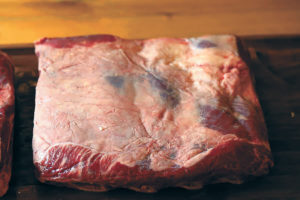 Short ribs often come with a layer of fat on top. In my experience, this is often only a couple of millimeters thick, and I leave it on. You can remove it if you wish, but nearly all of it will render out anyway and this layer of fat is added flavor!
Short ribs often come with a layer of fat on top. In my experience, this is often only a couple of millimeters thick, and I leave it on. You can remove it if you wish, but nearly all of it will render out anyway and this layer of fat is added flavor!
However, sometimes beef ribs will have a much thicker cap comprised of fat, meat, and silverskin which MUST be removed because the silverskin will not render down during cooking and is inedible.
This extra layer of meat is either (commonly believed to be) a piece of brisket, or it is the muscle that forms the ‘cap’ on a fore rib of beef. I’m not 100% sure which it is, but either way it cooks differently to the rib meat and stated, and must be removed, along with the silverskin between this meat and the rib meat.
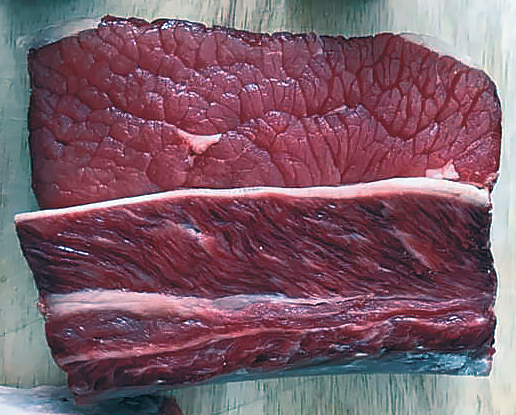
To check for this layer, look at your ribs from the side. If they are comprised of:
- Bone, thick meat, thin layer of fat, then you are good to go.
- Bone, thick meat, thin layer of fat, second layer of meat, second layer of fat, then you need to remove the fat cap and extra layer of meat.
When removing the fat cap in the second example, you must remove the topmost layer of fat and the top layer of meat between the two fat layers, which includes the inedible layer of silverskin.
Remove the Membrane – or Not?
On the bone side of the ribs is a membrane, and I like to remove this. This membrane is a thick, tough layer of connective tissue that remains very tough and chewy even after the meat is thoroughly cooked. Many people leave the membrane on, which is absolutely fine. It can be useful in that it helps prevent the meat from falling off the bone after cooking, and can simply be left (or eaten) from the finished product.
If you don’t want to mess about removing membrane from ribs, a good trick is to score it in a crisscross pattern, so some rub flavor gets through, and it shrinking during cooking doesn’t cause the rib meat to contract as much, curl up and disfigure.
Here’s How To Remove The Membrane
Personally, I always remove the membrane. Simply insert the end of a blunt knife into the area above one of the end ribs and lift the membrane.
Once you can get your finger in, remove the knife and use your finger to work the membrane loose until you have a loose corner, and you are able to grab it. You can now simply pull the membrane right off.
If you find your fingers slip while trying to pull it off, use some kitchen paper between your thumb and fingers which will provide the grip necessary. The membrane on beef ribs is tough, it rarely if ever rips, so you should be able to pull it off all in one go. However, if it does rip, work another part free and try again. With practice, you’ll become better and begin to find it easy.
Making the Rub
For this cook, I’ve gone with a slightly modified Texas rub. 60g black peppercorns, 20g of kosher salt, one tablespoon of garlic powder, one tablespoon of smoked paprika, one teaspoon cayenne pepper (optional, if you like just a little heat.)
Put your peppercorns into a pestle and mortar and grind away until the pepper is still relatively coarse. Then add the other ingredients, a few more grinds to mix thoroughly, and you’re done.
Coat the Ribs in Mustard
In order to help the rub stick, I like to cover the ribs in a thin layer of mustard. You could also use a thin layer of oil if you prefer.
Apply Dry Rub
Add copious amounts of rub, but not so much that the meat’s completely covered. You want to just see the meat through the rub in places. The first time you do this, it may seem like an excessive amount, but after such long cooking, the pepper in the rub will ‘soften’ somewhat, and the rub combines with the outer surface of the ribs to create an incredibly spicy, smoky, delicious bark, so apply the rub liberally.
Add Your Ribs to The Smoker
Put the ribs ‘rib side down’ directly onto the grates in your smoker that’s preheated to and holding a steady temp between 225 °F to 250 °F. Place a remote digital smoker thermometer temperature probe into the ribs, making sure it’s into one of the thickest parts and not touching bone.
Smoke for 4 Hours, Then Wrap With Liquid
For the first few hours of the cook, we want the ribs to take on a smoky flavor and the bark to develop. I find 4 hours is the sweet spot for this. Any less than 4 hours and the bark will not be good enough. Now it’s time to wrap if you choose.
I’ve done this both ways, both wrapped part way through and left unwrapped for the entirety of the cook, and both ways obtain good but slightly different results. If you want a slightly drier rib, with a more pronounced and deep, chewy bark, then leave the ribs uncovered for the duration. If you like a more moist and tender rib, with less ‘bite’ and more fall off the bone, then wrap part way through the cook.
Wrap or Not? How to Decide? It Depends on Marbling
Another factor to consider if deciding to wrap or not is the quality or grade of meat you have, particularly the amount of marbling in the ribs you are cooking. If you have USDA choice or lower quality, I would recommend wrapping them. There isn’t as much fat in them, and they can dry out if left unwrapped. If you have USDA Prime or better, with tons of marbling and intramuscular fat, then there’s no need to wrap, but you can if you wish.
In my house, we prefer to wrap our ribs. They tend to be much more tender and moist when wrapped with some braising liquid. I also find that regardless of the ribs I’m cooking, whether beef ribs or pork ribs, when wrapping, the results are more predictable as the tenderness of the finished product and how moist it remains is less dependent on the meat quality and amount of marbling. So, for this cook, I put them on the smoker for approx 4 hours to smoke before placing the ribs into silver trays with a couple of glugs of beer (or you can use beef stock) and then I sealed the trays with aluminum foil. I still left the temp probe in one of the racks to remotely monitor temps.
Cook To Tenderness, Not Temp
Leave the ribs cooking until they hit 200 °F in the thickest part, as shown by the remote temperature probe, then start to probe for tenderness. Note that not all ribs are the same and not all will be done at the same temp! Some can be ready at 203 °F, while some may need to go as high as 210 °F, depending on the makeup of the muscle, fat and connective tissues of the animal the ribs came from. The best way to check is they should be soft to the touch, have a little wobble, and ‘probe like butter’ if stuck with a toothpick, skewer or instant-read thermometer probe.
When Done, Remove, Wrap and Rest
When the ribs are cooked to the correct tenderness, remove them from the smoker, unwrap and remove from the tray with the braising liquid. Then wrap them again in either pink butcher paper or tin foil, and place into a cooler to rest for at least half an hour, with an hour being preferable.
Slice Into Individual Ribs and Serve
After they are rested, unwrap and slice into individual ribs to serve while still on the bone. One rib per person with sides is a good-sized portion, and serving with pickles and bread is a good combination. The pickles cut through the rib’s fattiness and richness, and the bread provides sustenance and is perfect to sop drippings.
Add Sauce if You Wish
You can add sauce if you like; return the ribs to the smoker for 10 minutes for the sauce to set and then serve. However, I prefer not to sauce them and instead provide a good sauce with some heat that people can help themselves to if they desire.
If you do decide to sauce your ribs, one with some heat goes very well, whereas an overly sweet sauce can be super sickly on top of the richness and fattiness of beef ribs, so please, don’t go too sweet with your choice of sauce.



